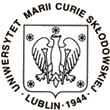

 |
 |
 |
|
Jan Styczen
IFJ, Cracow Deformation in light nuclei
In light nuclei, the interplay of the spherical and deformed structures is more pronounced and easier to study due to the relatively low numbers of protons and neutrons. In several those nuclei, e.g. 36,38Ar, 40Ca, superdeformed bands have been experimentally observed. Theoretically, both the shell model and the cluster model do predict in light nuclei large deformations i. e. existence of very deformed configurations having large quodrupole momentum and states connected by fast E2 transitions which can be associated also with SD bands. In the vicinity of 40Ca, extended calculations require complicated multi-particle multi-hole core excitations. Unlikely, in the vicinity of 48Cr, in the middle of the f7/2 shell, the observed rotational behavior is well accounted for by calculations restricted to the valence nucleons in the extended fp shell alone. In the light f7/2 shell nuclei, very regular rotational bands coexisting with yrast excitations have been identified in several odd-A, odd-odd and even-even nuclei. Properties of those bands are associated with the afore-mentioned cross-shell d3/2-f7/2 excitations. In most cases, band terminating states have been reached. In some nuclei, transitions are observed above those states, however, not classified as band continuation transitions. Moreover, the transition probabilities extracted from the experimentally measured lifetimes indicate a drop of the collectivity when approaching band termination. When we warm-up the nucleus and increase its angular momentum, the centrifugal force causes the nucleus to change its equilibrium shape from discussed above the spherical or prolate to an oblate. In hot nuclei, the oblate deformation increases and at certain critical value of spin a abrupt change of the oblate shape (non-collectively rotating) to a triaxial or again a very elongated prolate may occur. This phenomenon is called nuclear Jacobi transition. We shall discuss our recent data we have obtained in experiments at the VIVITRON In Strasbourg and with the use of the EUROBALL IV equipped with ancillary devices the Recoil Filter Detector and the HECTOR set-up. * In cooperation with: P. Bednarczyk, M. Lach, A. Maj, W. Męczyński, *** download abstract in doc file ***
| ||
Last modificated: 2003-09-22

